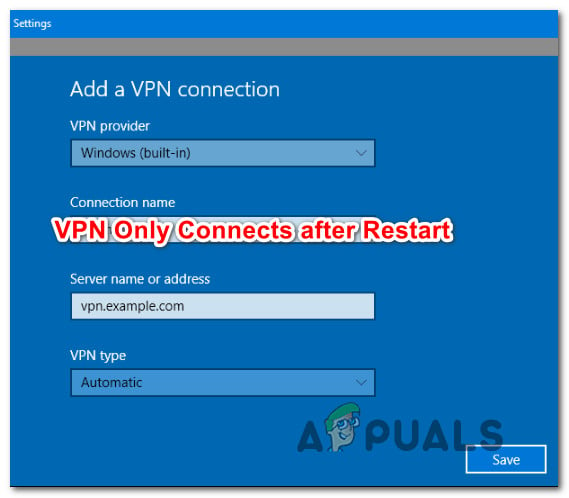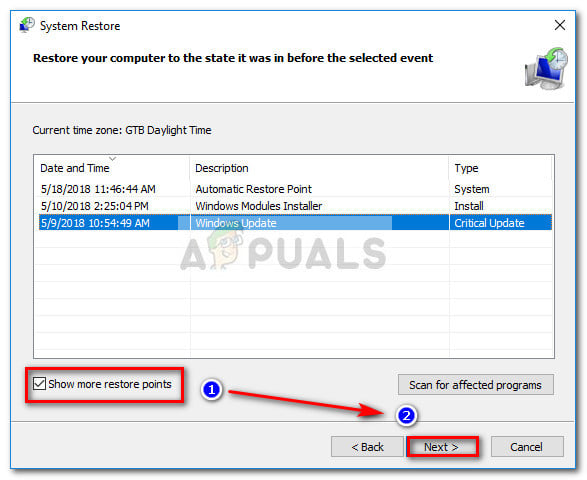What is causing Windows VPN to only Connect after Restart?
We investigated this particular issue by looking at various user reports and the repair strategies that are commonly being used to fix this particular problem. As it turns out, this particular issue can be caused by a number of different culprits: If you’re looking for a fix that will allow you to re-connect to your VPN network without having to restart every time, we have managed to identify a couple of potential fixes that other users in a similar situation have successfully used. Each of the methods below is confirmed to work by at least one affected user. For the best results, we advise you to follow the methods in the order that they are presented since they are ordered by efficiency and severity. One of them is bound to resolve the issue regardless of the culprit that is causing the issue.
Method 1: Doing a complete TCP/IP Reset
As it turns out, there seems to be a quick fix for this particular issue. You might be able to re-connect to your VPN by running a netsh reset ip command to recreate the connection. In most cases, users were successful in resolving the issue by running the series of commands necessary to perform a complete TCP/IP reset. But keep in mind that even if this works, it shouldn’t be regarded as a proper fix. It’s more likely than not to encounter the same issue the next time you try to disconnect from the built-in VPN. Here’s a quick guide on doing a complete netsh reset using an elevated Command Prompt: If you’re still unable to re-connect with the built-in VPN after a disconnect, move down to the next method below.
Method 2: Connect via the VPN menu
As it turns out, you might also lose the ability to re-connect to your built-in Windows VPN due to a Windows 10 glitch that only affects the tray-bar connection. Several affected users are successfully using a workaround that involves using the VPN menu (of the Settings app) instead of the more intuitive Tray-bar menu. Although this procedure will require some extra steps, it’s still better than having to restart every time you need to reconnect to your VPN. Here’s what you need to do: If this method is not working for you (you’re still unable to re-connect to your VPN without restarting), move down to the next method below.
Method 3: Disabling / Re-enabling connection
Another temporary fix that is confirmed to allow certain users to reconnect to the built-in Windows VPN without the need to restart every time is to Disable and then Enable the VPN connection via the Network and Sharing center. It’s still a temporary fix and it doesn’t treat the underlying cause of the issue, but it’s still better than having to restart every time. Here’s a quick guide on disabling and re-enabling the VPN connection via the Network Connections menu: If you’re still encountering the same issue or you’re looking for a permanent fix, move down to the next method below.
Method 4: Updating or Reinstalling the WAN Miniport PPTP
It’s also possible that the issue is being caused due to a Miniport PPTP adapter issue. It’s not uncommon that the issue occurs because the Miniport PPTP adapter is not disconnecting from the VPN connection when the action is being completed by the user. A couple of affected users that were in this exact scenario have reported that the issue was resolved after they reinstalled or updated the PPTP WAN Miniport device. Here’s a quick guide on how to update or reinstall the PPTP WAN Miniport: Note: If this scenario is not applicable as you’re not encountering the issue with a PPTP connection, skip the steps below and move directly to the next method. If the issue is still not resolved as you’re still unable to reconnect with the built-in VPN after the network is disconnected, move down to the next method below.
Method 5: Using System Restore to return back to a healthy state
If the issue only started to occur recently -the VPN connection used to reconnect normally-, you might be dealing with a corrupted file that is causing the built-in Windows VPN to become unable to reconnect. We managed to identify several reports where affected users said that the issue started occurring after a Windows update was installed. If this scenario is applicable to you, it probably means that a botched Windows update ended up breaking the VPN feature. If you’re perfectly fine with resolving the issue without identifying the culprit, a quick fix would be to simply use System Restore to return your machine to a state where everything was functioning normally. But keep in mind that going this route means that you’ll lose any application or update that you installed since the restore point was created. If you plan on using System Restore to fix the issue, here’s what you need to do: If the same issue is still occurring even after performing a System Restore, move down to the next method below.
Method 6: Creating a batch file using Rasdial.exe
If none of the methods above have worked for you, you might be able to resolve the issue by creating a batch file using the Rasdial.exe tool. This script will re-open your VPN connection without the need to restart as soon as you run it from an elevated Command Prompt. Here’s what you need to do: If the same issue is still occurring, move down to the next method below.
Method 7: Resetting PPTP and L2TP WAN Mini ports via CMD
Some affected users have reported that they managed to resolve the issue by resetting both the PPTP and L2TP mini ports from an elevated Command Prompt and restarting the computer. This procedure will reset any mini port that can be used by the Windows built-in VPN. This method is confirmed to work by several different Windows Users, on both Windows 10 and Windows 7. Here’s a quick guide with what you need to do to reset the PPTP and L2TP WAN Miniport:
Fix: Nord VPN not Connecting on Windows 10Fix: IPVanish not Connecting to VPNFix: VPN not working after 1709 UpdateFix: Apps Reopening Upon Shutdown/Restart After 1709 Update







